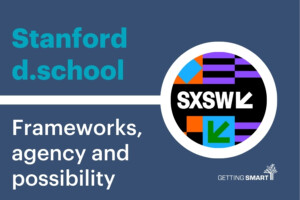Preparing Principals: Best Practices and Next Steps

We considered the question, “What do principals need to know and be able to do?” in the first blog in this series. The second post outlined next gen prep. This post recaps best practices and next steps.
Best Practices. As districts consider leadership pipeline and as states update licensure, they can incorporate, encourage and invest in best practices in leadership development. The experts described four key practices:
- Demanding hiring entities. Districts and networks can and should be more demanding about the demonstrated competence of aspiring principals. Groups or regions of districts working together could provide clear signals to providers about priorities.
- Partnerships between hiring entities and providers. Rather than the coursework disconnected from work experience now common, new providers are demonstrating that close partnerships between hiring entities and leadership development providers. As a variety of blended models proliferate, generic preparation will become less valuable and model specific partnerships will grow in importance.
- Linking coursework to real work. Angus McBeath, former Edmonton superintendent, said one of the most important jobs of a system head is to create a sequence of valuable leadership experiences for aspiring leaders-and blended learning creates more opportunity for teacher leadership roles. Alliance to Reform Education Leadership (AREL) recommends authentic learning experiences in real school settings over a significant period of time (at least 6 months) with candidates assuming real school leadership responsibilities. AREL, along with NYC Leadership Academy, is working with experts in the field to identify important developmental experiences for prospective leaders; their report will be released in 2014. New Leaders candidates spend a year as a resident administrator in a school with a master principal.
- Effective assessment and feedback. New Leaders preparation programs focus on 15 leadership actions. Leaders-in-training submit videos on these actions and receive rapid feedback. A similar approach could be used for principal evaluation more generally-frequent reviews of practice, actionable feedback in short cycles, that is rolled up into an overall evaluation.
Who pays? Typically, aspiring leaders pay for college degrees that make them eligible for administrative certification. (About half of the people taking these courses are seeking pay increases as teachers–a practice that doesn’t appear to improve results.)
New programs designed around competencies and based on best practices are typically philanthropically funded and free for high potential candidates. This arrangement has been useful for demonstrating the efficacy of new developmental pathways, but is not scalable. Shifting to a mixed payer system would help scale new approaches that yield effective leaders to become the norm.
Districts and networks that care about quality are often willing to pay for it. It can also be argued that aspiring leaders should have some skin in game. That could include accumulating payable associated with coursework that is forgiven when candidates complete the training and are placed. States could provide subsidies for training turnaround specialists, rural principals and other hard to staff categories.1
Next Steps. We’ve reviewed the emerging consensus among experts in principal preparation. One possible path forward for next-gen leadership development programs includes these developmental steps:
- Compile a competency map of what teacher leaders, school leaders, principal supervisors and system leaders need to know and be able to do.
- Update the map for new roles paying particular attention to the leadership implications of new school models and supporting organizations. (We appreciate that EdFuel is attempting to do this for the sector).
- Tag existing (open and proprietary) instructional content and resources to the competency map and identify gaps.
- Identify/develop a platform that facilitates assessment/observation of knowledge, skills and dispositions of aspiring leaders; supports individual learning plans; delivers playlists of content; suggests and tracks leadership development experiences; provides cohort collaboration features; and links to a professional portfolio and list of references. It would be really cool if the maps and experiences were tailored by specialization (e.g., startup, turnaround, blended, alternative, rural).
Recommendations. If states continue to license school leaders, they should:
- Use an outcome-focused accreditation/authorization process to approve preparation programs (for a period not to exceed five years) based on design adherence to best practices and the demonstrated effectiveness of graduates (See the Bush Institute’s report Operating in the Dark).
- Require accredited/authorized programs to use demonstrated competence rather than courses and credits to certify school leaders.
- Require school leaders and programs that prepare them to renew licensure based on demonstrated performance.
- Subsidize preparation for turnaround leaders, next-gen school leaders and other priority categories.
There is an opportunity to better prepare school leaders at lower expense (to the educator and state) with better outcomes than the degree focused licensing system common in all 50 states. Making the shift will require philanthropic investment, political courage on the part of state policy makers, and intentional partnerships between school operators and training providers. With higher expectations and the shift to digital learning, improving preparing principals offers a great chance to boost the achievement of American students.
This is the third of three posts on principal preparation and development. If you have thoughts about what principals should know and be able to do and how they should be prepared, please leave a comment below. We’d love to hear from you.





0 Comments
Leave a Comment
Your email address will not be published. All fields are required.